A stained tub brings your whole bathroom down. Clean it up! Our experts show you how.
Introduction
No one likes stepping into a creepy, stained bathtub, even if it's just for a quick shower where only your feet touch the tub. As for taking a long, hot bath? Absolutely not. When I was in my 20s, I moved into an apartment that was, on a good day, a bit of a dump. I could deal with the shabby exterior and the curious noises in the walls, but the rust-stained bathtub only fit for a horror movie needed attention ASAP.
I scrubbed and scrubbed, and it got a little better, but I didn't know as much about cleaning as I do now. I ended up damaging the acrylic with my abrasive choices. I sure wish I had pro cleaners at my disposal to set me on the right path. To help you where I failed, Family Handyman talked to pro cleaner Dan Deonarain, owner of NYC-based Galaxy Maids, and Alicia Sokolowski, president and co-CEO of AspenClean eco-friendly cleaning products. These two know cleaning, and below, they give multiple cleaning options for any tub type.
Here's how to get your bathtub looking like you can't wait to jump in.
Tools Required
- Nylon scrub brush
- Small bowl
- Soft Sponge
- Spray Bottle
Materials Required
- Baking soda
- Dish soap
- Hydrogen peroxide
- Lemon juice
- Rubber gloves
- Salt
- White vinegar
Project step-by-step (11)
Determine the type of stain
Sokolowski says it’s important to figure out what’s happening in your tub before starting. Here’s the breakdown:
- Red: This is probably rust. Old pipes and fittings or iron in your water can cause these stains.
- Black: “Black stains are commonly caused by mold or mildew buildup,” Sokolowski says. Poor ventilation and high moisture, common in bathrooms, cause mold.
- Blue/green: Sokolowski says degrading copper pipes can cause blue and/or green stains, especially if your water pH is too acidic.
- Pink: Pink stains are typically caused by bacteria, Sokolowski says, which “likes moist environments and can often be found in showers or bathtubs.”
- Yellow/brown: Hard water minerals like calcium, iron, or manganese, can cause yellow or brown stains, Sokolowski says. These colors could also be general grime and soap scum.
Ready to go? First, Deonarain talks about general stain cleaning, then Sokolowski breaks down methods for each type of stain so that you can tackle them specifically.
Prep the bathroom
- Remove all the soap, toys and shampoo bottles from the tub’s rim.
- Ventilate the bathroom by opening a window or turning on the exhaust fan.
- To protect your hands while using cleaning solutions, put on gloves.
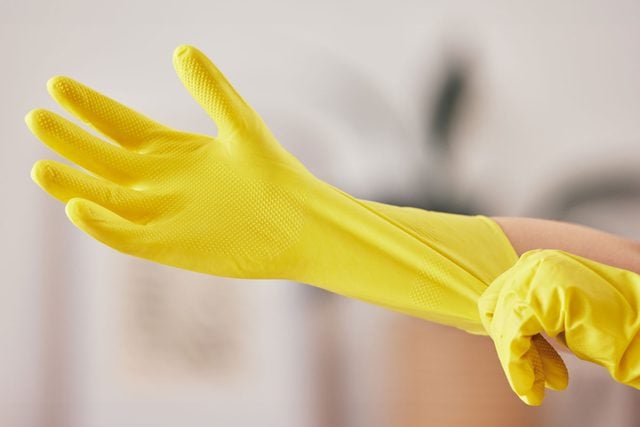
Start with the basics
Deonarain says he always starts with an easy, homemade cleaner: “When cleaning tough stains from bathtubs, start with the simplest approach, vinegar and dish soap,” which he says works for all types of mineral build-up and stains. Vinegar and dish soap are safe for porcelain, acrylic and fiberglass. Do not use vinegar on stone.
- Make a dish soap solution with warm water and a squirt of dish soap.
- Fill a spray bottle with a 50/50 mixture of the dish soap solution and white vinegar. Shake well.
- Spray or apply generously to the stain.
- Let it sit for 5 to 10 minutes.
- Scrub, rinse and repeat if necessary.
Get more aggressive
Next, you can try hydrogen peroxide and baking soda, Deonarain says. “We usually go with the vinegar and soap option first since it is milder,” but if stains are still present, he and his crew up the ante. “You may need to repeat for extremely stubborn stains,” he says. This method is safe for all types of tubs.
- Make a paste with two parts baking soda to one part hydrogen peroxide.
- Add more of either ingredient to get a paste that’s spreadable, not runny.
- Smear it on the stain and allow it to sit for 10 minutes.
- Lightly scrub with a soft sponge or brush.
- Rinse and repeat if necessary.
- Discard the paste. Do not keep for future use.
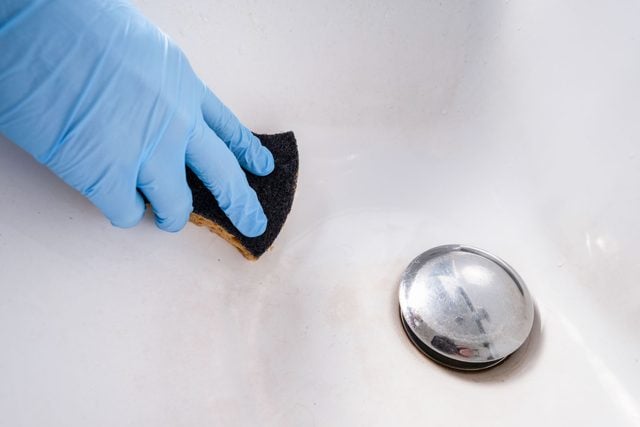
How to clean red bathtub stains
Sokolowski prefers lemon and salt to clean red rusty stains: “The lemon’s citric acid helps dissolve the rust, while the salt’s abrasive action assists in lifting the stains.” Don’t use lemon on stone and avoid abrasives like salt on acrylic and fiberglass tubs. (Believe me, acrylic will scratch!)
- Cut a lemon in half.
- Dunk the cut side into coarse salt.
- Rub the lemon half on the stain.
- Rinse well.
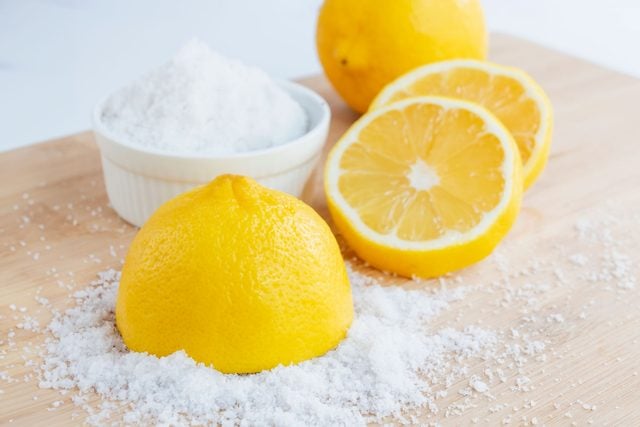
Pro tip: Vinegar is also a time-tested rust remover that can be used on everything except stone.
How to clean black bathtub stains
Mold finds a home wherever there is moisture, but Sokolowski says a baking soda paste will take care of these gross stains. Baking soda is gentle enough for all kinds of tubs.
- Make a paste by mixing water and baking soda until you have a spreadable mixture that’s not too runny.
- Apply it liberally to the black stains.
- Let sit for 30 minutes.
- Scrub with a nylon brush or soft sponge.
- Rinse well with water.
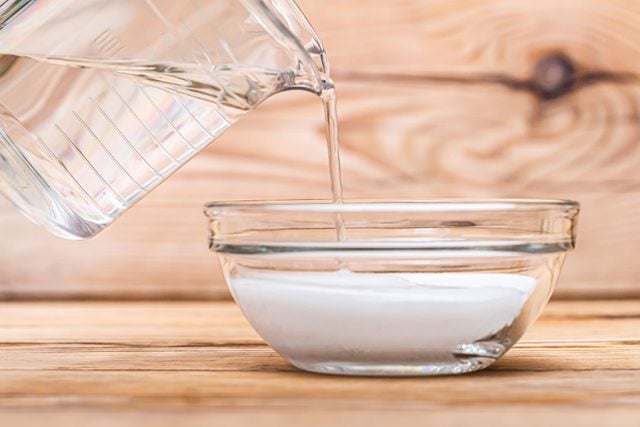
Pro tip: To reduce the chances of mold setting up shop in your bathroom, run your exhaust fan during and for 15 minutes after your shower.
How to clean blue/green bathtub stains
Sokolowski says lemon and salt are a good choice for copper-caused blue and green stains, just like the rusty red ones. Again, do not use salt on acrylic or fiberglass and avoid acidic cleaners if you have a stone tub.
- Cut a lemon in half.
- Dunk the cut side into coarse salt.
- Rub the lemon half on the stain.
- Rinse well.
How to clean pink bathtub stains
A pink stain in your bathtub, caused by biofilm-forming bacteria, may be scrubbed away with a good general cleaning. For lingering stains, Sokolowski says to use hydrogen peroxide. Hydrogen peroxide is safe for all tub surfaces.
- Fill a spray bottle 50/50 with hydrogen peroxide and water.
- Spray on pink stains.
- Let sit for 15 minutes.
- Scrub stains with a nylon brush or soft sponge.
- Rinse well.
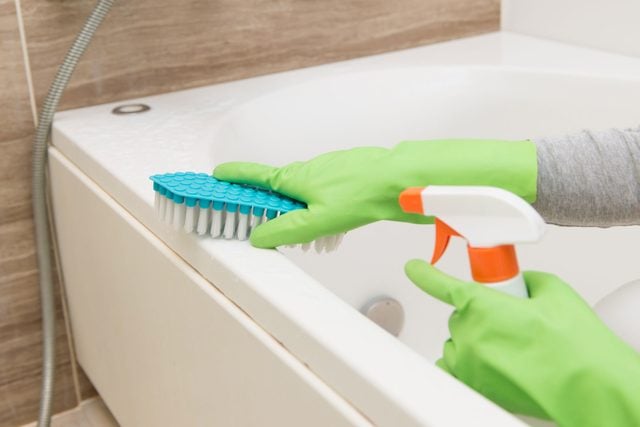
How to clean yellow and brown bathtub stains
Hard water leaves behind ugly rings and deposits ranging from yellow to brown, Sokolowski says. To dissolve hard water stains in your tub, do this:
- Fill your tub with enough white vinegar and water (50/50 mix) to cover the stained area.
- Alternatively, spray the stain if it’s on the rim or sides, or lay a vinegar/water-soaked towel on the stain.
- Let it soak for several hours or overnight.
- Drain the tub.
- Scrub the stains with a brush or sponge.
- Rinse thoroughly with water.
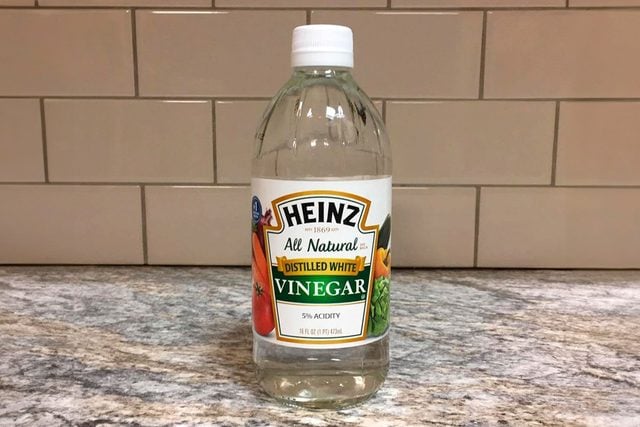
Keep your tub clean
Regular cleaning and maintenance will keep your tub shining. Use Deonarain’s dish soap and vinegar solution for general cleaning, or choose an eco-friendly cleaner that’s designed for tubs, Sokolowski says.
- Clean your tub every time you take a bath, so oils and soap scum don’t accumulate.
- Clean your shower once a week.
- Fix leaky faucets, and get any strange-smelling water checked out by a pro.
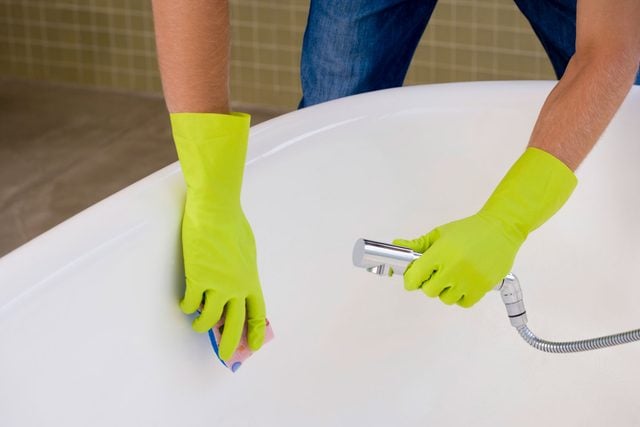
FAQs
Should I use bleach to clean my bathtub?
It depends. Bleach is safe for many bathroom surfaces, and it’s a great disinfectant, but it can damage stone and tile, especially if it’s chipped or cracked. The pros prefer less caustic solutions like vinegar, baking soda and commercial cleaners designed for tubs.
Also, learn how to unclog bathtub’s drain without chemicals.
Will vinegar damage my bathtub?
It depends. Vinegar is safe for acrylic, fiberglass and porcelain. Do not use vinegar on stone tubs, as the acid could etch the stone or sealant.
What are the brown stains in my bathtub?
It could be hard water deposits, or rust if it’s reddish-brown. General grime from body oils and soap scum might be brown, too.
When to call a pro
If you’re looking at rust stains from dripping pipes, fix them. You could have degrading or corroded pipes. Sokolowski adds: “If stains persist despite cleaning efforts, it may be necessary to investigate the water quality or consult a professional plumber for further assistance.”
About the Experts
Dan Deonarain owns Galaxy Maids, a residential and commercial cleaning and maid service. He has decades of experience cleaning homes, apartments and offices in the New York City area.
Alicia Sokolowski is the president and co-CEO of AspenClean, maker of environmentally conscious and cruelty-free cleaning products.





















